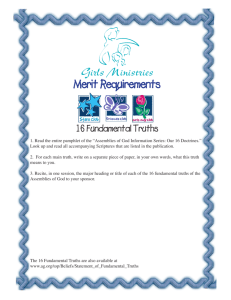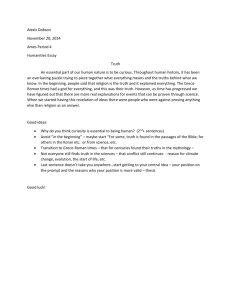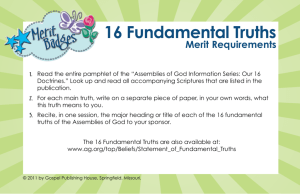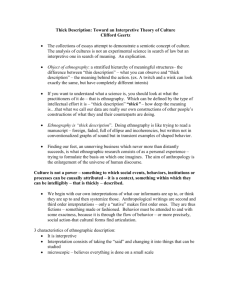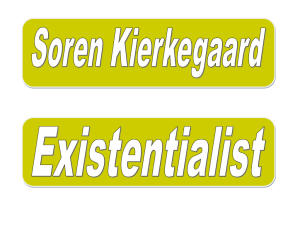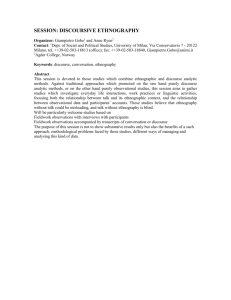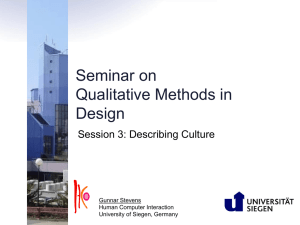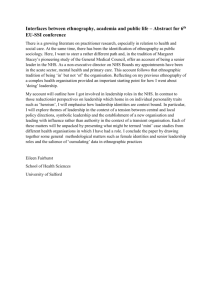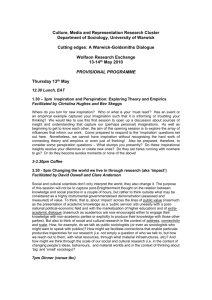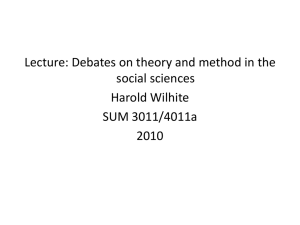Scholar/Scientist
advertisement
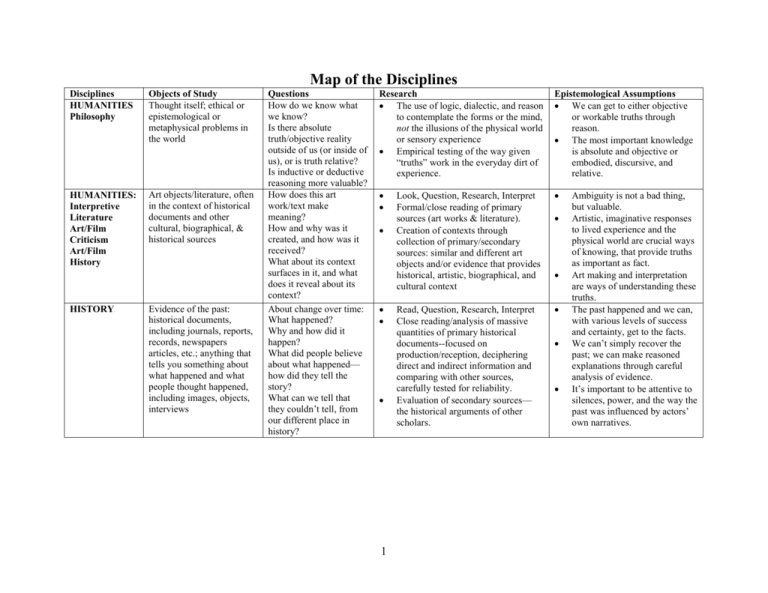
Map of the Disciplines Disciplines HUMANITIES Philosophy Objects of Study Thought itself; ethical or epistemological or metaphysical problems in the world HUMANITIES: Interpretive Literature Art/Film Criticism Art/Film History Art objects/literature, often in the context of historical documents and other cultural, biographical, & historical sources HISTORY Evidence of the past: historical documents, including journals, reports, records, newspapers articles, etc.; anything that tells you something about what happened and what people thought happened, including images, objects, interviews Questions How do we know what we know? Is there absolute truth/objective reality outside of us (or inside of us), or is truth relative? Is inductive or deductive reasoning more valuable? How does this art work/text make meaning? How and why was it created, and how was it received? What about its context surfaces in it, and what does it reveal about its context? About change over time: What happened? Why and how did it happen? What did people believe about what happened— how did they tell the story? What can we tell that they couldn’t tell, from our different place in history? Research The use of logic, dialectic, and reason to contemplate the forms or the mind, not the illusions of the physical world or sensory experience Empirical testing of the way given “truths” work in the everyday dirt of experience. Epistemological Assumptions We can get to either objective or workable truths through reason. The most important knowledge is absolute and objective or embodied, discursive, and relative. Look, Question, Research, Interpret Formal/close reading of primary sources (art works & literature). Creation of contexts through collection of primary/secondary sources: similar and different art objects and/or evidence that provides historical, artistic, biographical, and cultural context Read, Question, Research, Interpret Close reading/analysis of massive quantities of primary historical documents--focused on production/reception, deciphering direct and indirect information and comparing with other sources, carefully tested for reliability. Evaluation of secondary sources— the historical arguments of other scholars. 1 Ambiguity is not a bad thing, but valuable. Artistic, imaginative responses to lived experience and the physical world are crucial ways of knowing, that provide truths as important as fact. Art making and interpretation are ways of understanding these truths. The past happened and we can, with various levels of success and certainty, get to the facts. We can’t simply recover the past; we can make reasoned explanations through careful analysis of evidence. It’s important to be attentive to silences, power, and the way the past was influenced by actors’ own narratives. WOK Course Map, cont. Discipline/Key Objects of Study Terms People in the midst of their ANTHROPOLOGY cultures, and all their Key terms: Culture significations: language, Cultural relativism clothing, objects, rituals, Ethnography other individual and Thick description collective practices; Qualitative research people’s own Participantinterpretations of observation themselves and their Interpretation cultures Theory SOCIOLOGY Key terms: Social Variable Statistical Analysis Demography Quantitative research Ethnography Theory Verifiability BIOLOGY Key terms: Hypothesis Theory Skepticism Objectivity Model Positivism Empirical research Epigenetics Verifiability People in the midst of their social groups and dynamics, and the data about groups and dynamics that can be gathered by comparing various factors across groups, time, and place. Natural life, from microscopic to macroscopic scales: molecules, cells, tissues, organs, individual animals, populations of animals, communities, ecosystems, and the biosphere Questions Research What does this conversation or practice mean? What about a given culture surfaces in this act of signification or ritual? What are this culture’s values? What are its ambivalences and contradictions? How is human (inter-) subjectivity at play here? How am I as a researcher influencing my results? How does this group’s behavior compare to other group’s behaviors? What is the social aspect of this phenomenon? What is the trend? Which variables correlate? Which caused the trend? What are the causes of inequality? How did it begin? How and did it change over time? What is it for? How is it built? How does it work? What goes wrong, and how is it fixed? Usually qualitative: Ethnography (participant observation), interpretive analysis, discussion of theoretical frameworks, open-ended interviews, life histories, archival work, ‘thick’ descriptions of events and images and texts (from literature to court rulings). When ethnographic methods are used: Participation/observation is considered partial and ongoing: goal is dialogue with subjects, make explicit limitations of researcher’s position and analysis, discuss limits of writing and speech Often quantitative: Census, survey, questionnaire, controlled and structured interviews, statistical analysis, charts & tables, focus groups, social network mapping, controlled and/or randomly selected participants (when possible), Comparative historical, ethnography. When ethnographic methods are used, the goal is limitation of factors and variables that affect observed activity Gathering observable, empirical, verifiable evidence through fieldwork and/or experimentation, to create and test hypotheses using repeatable steps. But also: reconstructing the history of species and predicting the future by inference from observable evidence; inferring molecular structures from chemical and physical knowledge. Epistemological Assumptions Beliefs and practices are culturally relative. Quantitative studies can conceal both their subjective nature and the truths about culture that only surface through interpretation. Researchers should foreground their own subjectivity. 2 Society is worthy of study in its own right; even the most individual of acts reveal something about the social order. Sometimes: the best knowledge can be verified; researchers should strive to counter their own bias. “There is a real world, independent of human perception.” (M 34) The world is “not chaotic but structured.” (M 34)) There is “historical and causal continuity among all phenomenon in the material universe.” (M 35) All species evolved from the same organisms through natural selection.
